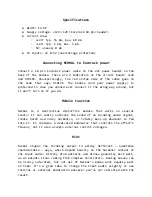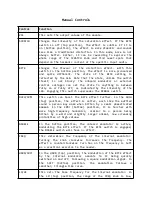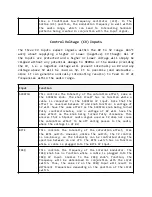
Manual Controls
Control
Function
VOL
This sets the output volume of the module.
SCRATCH
Changes the intensity of the saturation effect. If the BITE
switch is off (top position), the effect is subtle. If it is
on (bottom position), the effect is more dramatic and sounds
less like a traditional distortion. In this mode, more is not
always better. Rather, it can be rewarding to explore the
whole range of the SCRATCH knob and find sweet spots that
depend on the harmonic content of the specific input audio.
BITE
Changes
the
flavour
of
the
distortion effect. With this
switch in the bottom position, the effect is more pronounced
and
quite
different.
The
state
of
the
BITE
setting
is
reflected by the LED. Note that the state, unlike the switch
itself, is not binary: The onboard modulator or external
control voltages can set the state to anything in between
fully on or fully off, as indicated by the intensity of the
LED. Engaging this switch supersedes the NIBBLE switch.
OUCH/F#%!
This switch can boost the BITE effect further. In the OUCH
(top) position, the effect is softer, much like the muffled
sound a person may make when bitten by a small domesticated
mammal. In the F#%! (bottom) position, it is harsher with
more
high-frequency
harmonics,
similar to a person being
bitten by a wild and slightly larger animal, now screaming
profanities at high volume.
NIBBLE
In the bottom position, the onboard modulator is active,
modulating the BITE effect. If the BITE switch is engaged,
the NIBBLE switch will have no effect.
FREQ
This
determines
the
frequency of the internal modulator.
Turning
the
knob
clockwise
increases
the
frequency.
The
effect a counterclockwise turn has on the frequency is left
as a practical exercise to the reader.
HARD/SOFT
In the HARD (top) position, the modulation of the BITE effect
by
the
internal
modulator
amounts
to
it
being
quickly
switched on and off, following a square modulation signal. In
the
SOFT
(bottom)
position,
the
modulation
follows
a
smoother, triangle-like curve.
LO/HI
This sets the base frequency for the internal modulator. In
the LO (top) position, the range of the FREQ knob is low,






















